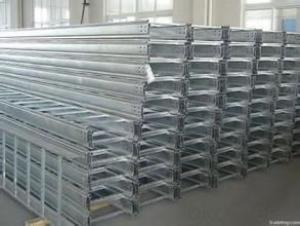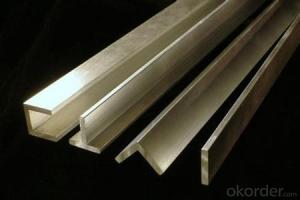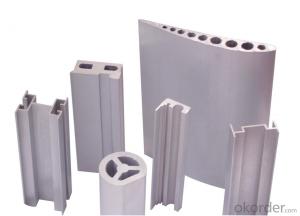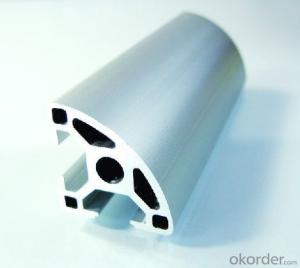various surface treatment Grade Top industrial aluminium profile extrusion
OKorder Service Pledge
OKorder Financial Service
You Might Also Like
Aluminium is a relatively soft, durable, lightweight, ductileand malleablemetalwith appearance ranging from silvery to dull gray, depending on the surfaceroughness. It is nonmagnetic and does not easily ignite. A fresh film ofaluminium serves as a good reflector (approximately 92%) of visible lightand an excellent reflector (as much as 98%) of medium and far infraredradiation. The yield strength of pure aluminium is 7–11 MPa,while aluminium alloys have yield strengths ranging from200 MPa to 600 MPa. Aluminium has about one-third the densityand stiffness of steel. It is easily machined,cast, drawn and extruded.
Features:
Material | Alloy 6063,6061,6005or according to customer’s choice |
Temper | T3, T4, T5, T6 |
Surface | Anodize, electrophoresis, powder coating, PVDF coating, wood grain painting, matted, etc. |
Length | Coating 6.5 meters, Anodizing 6.5 meters, Mill finish 5 meters |
Application | Industrial, electrical equipment(TV set, air conditioner, refrigerator, computer), decoration,construction, transportation |
Custom Made | We can package following with customer's request. |
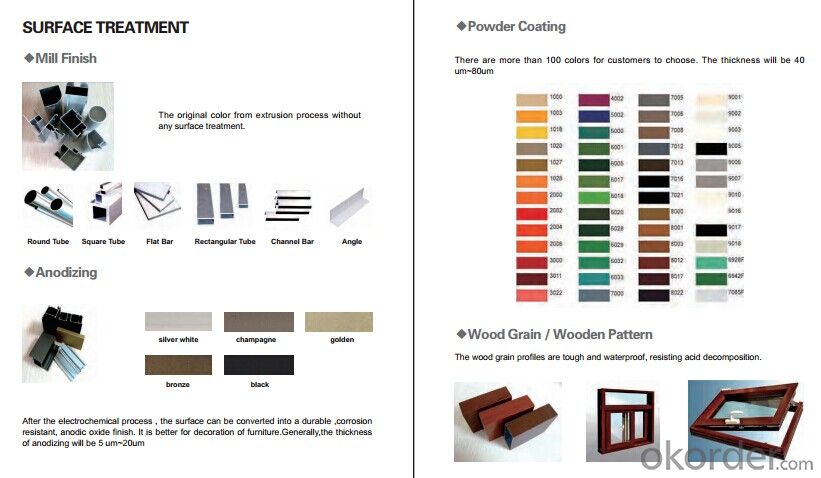

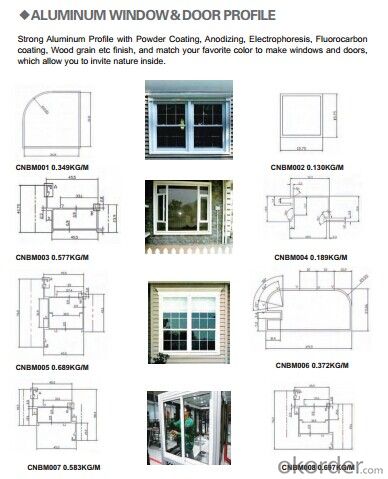
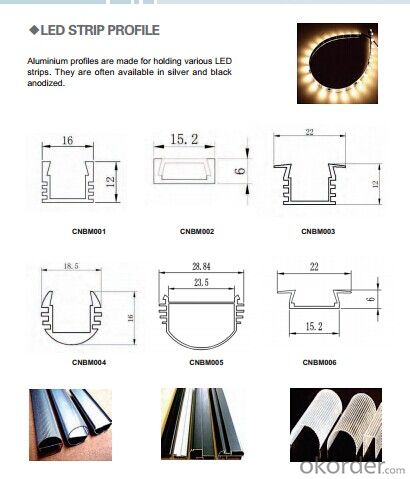
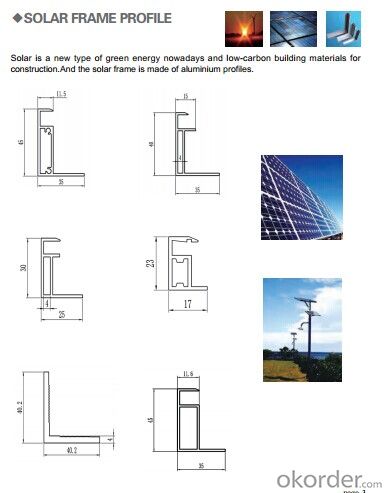
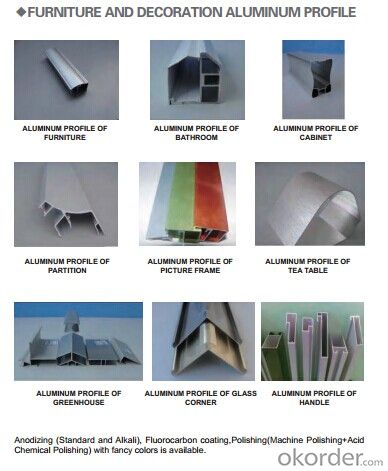
- Q:Are aluminum profiles suitable for the furniture industry?
- Aluminum profiles prove to be an excellent choice for the furniture industry due to their many advantages. The versatility and durability of aluminum make it a highly sought-after material for furniture manufacturing. To begin with, the lightweight nature of aluminum profiles simplifies handling and transportation, particularly for larger furniture pieces. Not only does this decrease transportation expenses, but it also enhances the user-friendliness of the furniture during installation and rearrangement. Furthermore, aluminum's remarkable resistance to corrosion ensures that furniture made with aluminum profiles can endure harsh weather conditions and maintain its durability over time. This quality makes it suitable for both indoor and outdoor furniture applications. In addition, aluminum profiles offer exceptional design flexibility. The ease with which aluminum can be extruded into various shapes and sizes allows for limitless design possibilities. This versatility facilitates the creation of customized furniture pieces that cater to specific client requirements. Moreover, the strength-to-weight ratio of aluminum profiles is commendable. Furniture constructed with aluminum becomes robust and long-lasting, which is particularly advantageous for items that experience regular use, such as chairs and tables. Additionally, aluminum is an environmentally-friendly material, as it is fully recyclable. This aligns with the increasing demand for sustainable furniture options. Manufacturers can effortlessly recycle aluminum profiles at the end of their lifecycle and employ the recycled material to fashion new furniture items, thereby reducing waste and contributing to a circular economy. In conclusion, the unique attributes of aluminum profiles make them highly fitting for the furniture industry. Their lightweight composition, resistance to corrosion, design flexibility, strength, and recyclability collectively contribute to the creation of superior-quality and sustainable furniture products.
- Q:Can aluminum profiles be used for modular systems or frameworks?
- Indeed, modular systems or frameworks can utilize aluminum profiles. These profiles possess the qualities of being lightweight, sturdy, and exhibiting exceptional structural integrity, rendering them an optimal selection for the construction of modular systems or frameworks. The ease with which these profiles can be assembled and disassembled grants designers the freedom to modify and adjust structures as needed. Moreover, aluminum profiles exhibit commendable resistance against corrosion, rendering them appropriate for both indoor and outdoor applications. Furthermore, their sleek and contemporary aesthetic appeal contributes to their popularity in architectural and industrial design. In conclusion, aluminum profiles represent a versatile and trustworthy choice for the creation of modular systems or frameworks.
- Q:How to distinguish the true and false of aluminum profile
- 1. Light weight 2. 3 and after the incision is white within 4 hard, very fine very hard
- Q:What are the different types of surface coatings for aluminum profiles?
- There are several different types of surface coatings that can be applied to aluminum profiles, each with their own unique characteristics and benefits. 1. Anodizing: Anodizing is a popular coating method that involves creating a protective oxide layer on the surface of the aluminum. This layer not only enhances the appearance of the profile but also improves its resistance to corrosion, wear, and scratches. Anodized aluminum profiles can be further enhanced through color dyeing or other finishing techniques. 2. Powder coating: Powder coating is a dry finishing process that involves applying a powdered coating material to the aluminum profile. The powder is electrostatically charged and then applied to the profile, after which it is heated to form a durable and attractive coating. Powder coating offers excellent protection against scratches, UV rays, and chemical damage, making it a popular choice for outdoor applications. 3. Liquid paint coating: Liquid paint coatings can also be applied to aluminum profiles. This method involves spraying or dipping the profile into a liquid paint solution, which is then cured to form a tough and durable finish. Liquid paint coatings offer a wide range of color options and can be customized to achieve specific aesthetic requirements. 4. PVDF coating: Polyvinylidene fluoride (PVDF) is a high-performance coating material that provides exceptional resistance to weathering, fading, and corrosion. PVDF coatings are typically applied through a liquid paint process and can be used to achieve long-lasting and vibrant finishes on aluminum profiles, especially in architectural applications. 5. E-coating: Electrocoating, also known as electrophoretic deposition (EPD), involves immersing the aluminum profile in a bath of paint or coating solution and applying an electric current to deposit the paint uniformly onto the surface. E-coating provides excellent coverage and adhesion, making it suitable for complex-shaped profiles. It also offers good corrosion resistance and can be used as a primer before applying other coatings. Overall, the choice of surface coating for aluminum profiles depends on the specific requirements of the application, including desired appearance, durability, corrosion resistance, and environmental factors. Each type of coating has its own advantages and limitations, so it is important to carefully consider these factors before making a selection.
- Q:What are the different types of protective coatings for aluminum profiles?
- There are several different types of protective coatings available for aluminum profiles. These coatings are designed to enhance the durability and longevity of the aluminum, while also providing aesthetic appeal. Some of the common types of protective coatings for aluminum profiles include: 1. Anodizing: Anodizing is one of the most popular and widely used protective coatings for aluminum. It involves an electrochemical process that creates a thin, transparent layer of aluminum oxide on the surface of the metal. This layer provides excellent corrosion resistance and can be further enhanced with various dye colors. 2. Powder Coating: Powder coating is a dry finishing process that involves applying a free-flowing, electrostatically charged powder onto the aluminum surface. The powder is then cured under heat, creating a durable and protective coating. Powder coating offers excellent resistance to impact, chemicals, and corrosion, and it provides a uniform and attractive finish. 3. Paint Coating: Paint coatings are commonly used for aluminum profiles, especially in applications where aesthetics is important. These coatings can be applied using various methods such as spraying, brushing, or dipping. Paint coatings provide protection against corrosion, UV rays, and other environmental factors, while also offering a wide range of color options. 4. E-Coating: E-coating, also known as electrocoating or electrophoretic deposition, is an immersion-based coating process. It involves submerging the aluminum profiles in a tank filled with a water-based paint solution and applying an electric current. This causes the paint particles to migrate and deposit onto the aluminum surface, resulting in a uniform and protective coating. E-coating provides excellent corrosion resistance and is often used as a primer before applying other coatings. 5. Clear Coating: Clear coatings are transparent protective layers that are often used to preserve the natural appearance of aluminum profiles while providing protection against corrosion and other environmental factors. These coatings can be applied as clear lacquers or clear anodizing, depending on the desired level of protection. It is important to consider the specific requirements of your aluminum profiles and the intended application when choosing a protective coating. Factors such as durability, corrosion resistance, aesthetics, and cost should be taken into account to ensure the best choice for your specific needs.
- Q:How are aluminum profiles cut and shaped?
- Aluminum profiles are cut and shaped using various methods such as sawing, milling, drilling, and bending. Sawing is the most common method, where a circular saw or bandsaw is used to cut the aluminum profiles to the desired length. Milling involves removing excess material using a rotating cutting tool to create specific shapes and designs. Drilling is used to create holes in the profiles using a drill bit. Lastly, bending is employed to shape the profiles by applying force to bend them into the desired angles or curves.
- Q:Are aluminum profiles suitable for use in mining and construction equipment?
- Yes, aluminum profiles are suitable for use in mining and construction equipment. Aluminum is a lightweight and durable material that offers excellent corrosion resistance, making it ideal for heavy-duty applications in these industries. Additionally, aluminum profiles can be easily customized and fabricated to meet specific design requirements, enhancing their suitability for use in mining and construction equipment.
- Q:Can aluminum profiles be used in electrical panel manufacturing?
- Yes, aluminum profiles can be used in electrical panel manufacturing. Aluminum is a lightweight and durable material that offers excellent electrical conductivity, making it suitable for use in electrical panels. It also has good heat dissipation properties, which is important for preventing overheating in electrical systems. Aluminum profiles can be easily fabricated and customized to meet the specific requirements of electrical panel designs. Additionally, aluminum is resistant to corrosion, which ensures the longevity of the electrical panel. Overall, aluminum profiles are a popular choice in electrical panel manufacturing due to their numerous benefits.
- Q:Can aluminum profiles be used for modular exhibition booths?
- Yes, aluminum profiles are commonly used for modular exhibition booths due to their lightweight, durable, and versatile nature. They allow for easy assembly and disassembly, making them ideal for creating flexible and customizable booth layouts. Additionally, aluminum profiles provide a sleek and professional appearance, enhancing the overall aesthetics of the exhibition booth.
- Q:5002 and 6063 aluminum profiles difference
- Sometimes, a small amount of copper or zinc is added to improve the strength of the alloy, while the strength of the alloy is increasedAnd the corrosion resistance decreased significantly; there is a small amount of copper conductive materials, titanium and iron in order to offset the adverse effects on the conductivity of the zirconium or titanium; recrystallization grain refinement and control; in order to improve the cutting performance, can be addedLead and bismuth. In Mg2Si, Mg/SiWhen the ratio is 1.73, in the heat treatment state, the Mg2Si is melted in aluminum, and the alloy has the artificial aging hardening function.
1. Manufacturer Overview |
|
|---|---|
| Location | |
| Year Established | |
| Annual Output Value | |
| Main Markets | |
| Company Certifications | |
2. Manufacturer Certificates |
|
|---|---|
| a) Certification Name | |
| Range | |
| Reference | |
| Validity Period | |
3. Manufacturer Capability |
|
|---|---|
| a)Trade Capacity | |
| Nearest Port | |
| Export Percentage | |
| No.of Employees in Trade Department | |
| Language Spoken: | |
| b)Factory Information | |
| Factory Size: | |
| No. of Production Lines | |
| Contract Manufacturing | |
| Product Price Range | |
Send your message to us
various surface treatment Grade Top industrial aluminium profile extrusion
OKorder Service Pledge
OKorder Financial Service
Similar products
New products
Hot products
Related keywords
